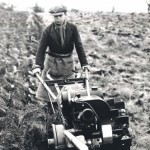Home › Forums › The Machinery Forums › Pedestrian operated machines › Allen Scythe Cutter Bar
- This topic has 2 replies, 2 voices, and was last updated 2 years, 6 months ago by
rowan-bradley.
-
AuthorPosts
-
October 5, 2021 at 4:13 pm #38009
rowan-bradley
ParticipantI have just discovered that the Allen Scythe that I am trying to restore has a bent finger bar. If you lay the finger bar on a level surface, the normal way up, the centre is touching the surface, but the ends are about 8mm above it. Presumably it’s not meant to be like this? Do I just try to bend it back, or do I need to try to make a new one?
I found this while trying to find out why the blades near the middle didn’t seem to touch the fingers. which presumably means that it will just chew the grass, rather than cutting it. I’m still not quite sure that this bend really explains the problem. I’d rather not have to take all the fingers off the bar to investigate, because I expect that a lot of the bolts are rusted up, and will probably break rather than coming undone.
Thanks – Rowan
October 6, 2021 at 8:12 am #38010 trusty220Keymaster
trusty220KeymasterYou should be able to adjust the main support bar by bending it in stages to get it flat again. The normal way set these old finger bars was to stretch a piece of string between the two extremities and use gentle force to persuade the bar to move back flat again; hitting it with a hammer should be avoided, better to put part of it in a vice and use a lever to bend it back, then move along and repeat the process in gradual stages until the whole bar is flat.
Once the bar is flat you can fine tune it by bending each individual finger up or down so that the sliding knife makes a scissor action with each finger. If you don’t get a scissor action it will put excess pressure on the drivetrain and give a poor cut- have you ever tried cutting wet cardboard with blunt scissors? It would be the same effect.
October 6, 2021 at 1:34 pm #38016rowan-bradley
ParticipantThat sounds a good plan. I will give it a go. By “bending the individual fingers” do you mean bending the actual finger (which I think is cast, and would break rather than bending), or bending the bar underneath each finger (which sounds a very difficult process, because each bend would affect the whole bar, not just the one finger). I would have thought that fitting shims under any fingers that need to be raised would be a better approach. But I’m not worrying about that until we find out whether it’s a problem on my machine.
Thanks – Rowan
-
AuthorPosts
- You must be logged in to reply to this topic.
